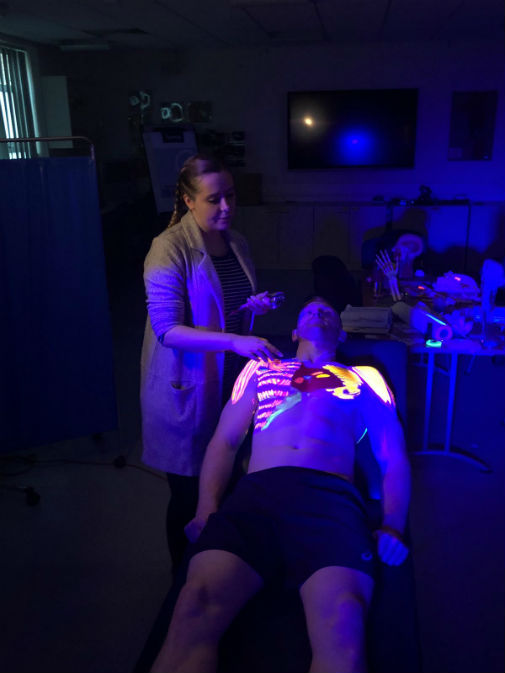Lighting up the way medical students learn anatomy
Posted on 10 January 2019

Ultraviolet painting presents a unique view of human anatomy that is visually striking.
It is also a frequently observed activity within the anatomy classrooms of medical schools around the world.
But now lecturers at Hull York Medical School are pioneering the use of body paint and ultraviolet light to help teach anatomy to students.
Fluorescent colour
Although the use of body paint in medical schools is not new, it is believed the use of ultraviolet light is a first.
UV paint provides a “wet and more visceral look” and coupled with the fluorescent colour provides a striking model for the students to study.
The technique has been piloted at Hull York Medical School and will be fully embedded into a new module in anatomy this term.
Students are taught in groups of 10-12 with the technique applied on a model or classroom volunteer.
Unique view
Professor Gabrielle Finn, Director of the Health Professions Education Unit at Hull York Medical School, said the technique was proving extremely popular with students.
She said: “The use of body paint has been around in medical schools for the past decade, but no-one is using UV.”
“Ultraviolet painting presents a unique view of human anatomy that is visually striking – highlighting muscle tensions and the connections between parts of the body.
“Students are able to visualise the layers under the skin in a way they can’t with normal body paint so when they are examining a patient during their clinical practice then can recall those images of anatomy to better understand what they are feeling and the connections between parts of the body.
“It is a very memorable way to learn and is a lot more fun and students really engage with it."
Explore more news

New butterfly species created 200,000 years ago by two species interbreeding
Thursday 18 April 2024

Children in the North at greater risk of entering care
Wednesday 17 April 2024

Boreal forest and tundra regions worst hit over next 500 years of climate change, study shows
Monday 8 April 2024

Researchers developing ultra-sensitive blood test with potential to revolutionise diagnosis of Alzheimer’s
Thursday 4 April 2024

Attitudes to being an adult are shifting as traditional milestones become out of reach, new study finds
Wednesday 27 March 2024
Media enquiries
About this research
The findings are outlined in a paper published in the European Journal of Anatomy.
Explore our research here.
